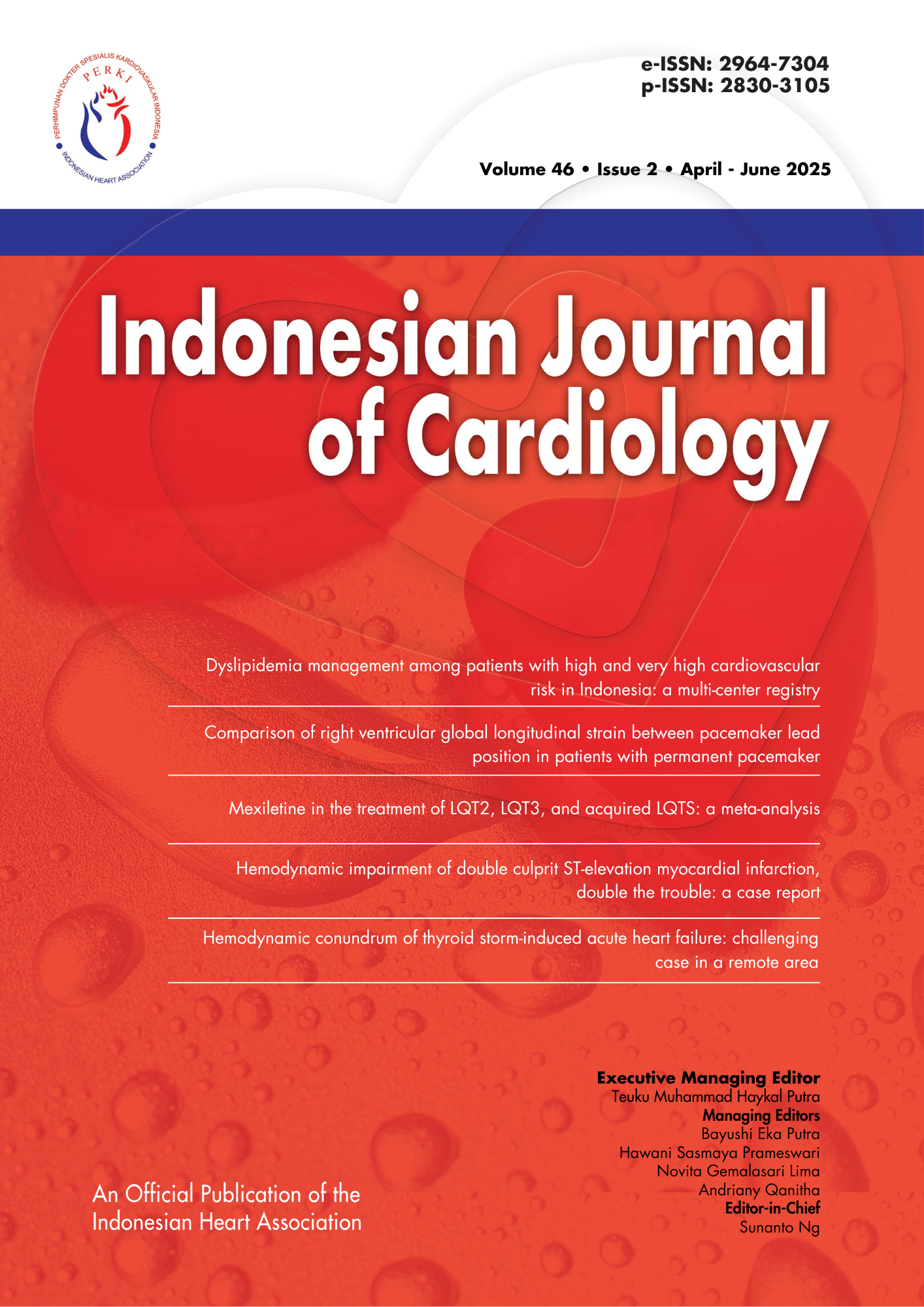Comparison of right ventricular global longitudinal strain between pacemaker lead position in patients with permanent pacemaker
Abstract
Background: The implantation of a permanent pacemaker (PPM) can reduce right ventricular function. Echocardiography using speckle tracking can detect a decreasing in right ventricular function earlier. The value of right ventricular global longitudinal strain (RVGLS) based on the location of the pacemaker lead between the apex and non-apex was currently unknown, although the placement of the correct pacemaker lead location was very important for evaluating right ventricular dysfunction to prevent right heart failure. This study aims to determined the comparison of RVGLS between pacemaker lead position in patients with permanent pacemaker.
Methods: This study was a nested case-control study to assess the comparison of RVGLS between pacemaker lead position in patients with permanent pacemaker, who were divided into the right ventricular apex group (RVA) and the non-right ventricular apex group (NRVA). This study used data from the pacemaker registry and medical records of patients who had undergone pacemaker implantation since June 2021. The shapiro-wilk normality test was performed before analyzing all numerical data, followed by an independent t-test or Mann-Whitney test to determine the differences between groups.
Results: In this study, there were 38 patients with permanent pacemakers, consisting of 18 samples with RVA group and 20 samples with NRVA group. In this study, no significant differences were found in age, sex, diagnosis, comorbidities, therapy, pacemaker mode, baseline QRS duration, pacing burden, puncture site, and initial echocardiography between of two groups. There was a significant difference in paced QRS duration between the RVA and RVNA groups (160 + 20 ms vs 140 + 28 ms, p=0.024). Based on statistical analysis, there was a significant difference in the value of RVGLS in the RVA group compared to the RVNA group (-14.87+4.48% vs -18.40+3.21%, p=0.015).
Conclusion: The position of the apex right ventricular lead resulted in a lower value of RVGLS compared to the position of the non-apex right ventricular lead.
Downloads
References
2. Sofian Johar UP, Aamir Hameed Khan, Wataru Shimizu, Dicky A Hanafy, Seil Oh, Ching Chi Kepngmn. White book. Asia Pasific Rhytm Society. 2021:25-30.
3. Gupta H, Showkat HI, Aslam N, Tandon R, Wander G, Gupta S, et al. Chronology of cardiac dysfunction after permanent pacemaker implantation: an observational 2 year prospective study in North India. International Journal of Arrhythmia. 2021;22(1):11.
4. Sinkar K, Bachani N, Bagchi A, Jadwani J, Panicker GK, Bansal R, et al. Is the right ventricular function affected by permanent pacemaker? Pacing and Clinical Electrophysiology. 2021;44(5):929-35.
5. Saito M, Iannaccone A, Kaye G, Negishi K, Kosmala W, Marwick TH. Effect of right ventricular pacing on right ventricular mechanics and tricuspid regurgitation in patients with high-grade atrioventricular block and sinus rhythm (from the protection of left ventricular function during right ventricular pacing study). The American Journal of Cardiology. 2015;116(12):1875-82.
6. Yu Y-J, Chen Y, Lau C-P, Liu Y-X, Wu M-Z, Chen Y-Y, et al. Nonapical right ventricular pacing is associated with less tricuspid valve interference and long-term Progress of tricuspid regurgitation. Journal of the American Society of Echocardiography. 2020;33(11):1375-83.
7. Zaidi A, Knight DS, Augustine DX, Harkness A, Oxborough D, Pearce K, et al. Echocardiographic assessment of the right heart in adults: a practical guideline from the British Society of Echocardiography. Echo Research and Practice. 2020;7(1):G19-G41.
8. Fabiani I, Pugliese NR, Santini V, Conte L, Di Bello V. Speckle-tracking imaging, principles and clinical applications: A review for clinical cardiologists. Echocardiography in Heart Failure and Cardiac Electrophysiology. 2016:85-114.
9. Ji M, Wu W, He L, Gao L, Zhang Y, Lin Y, et al. Right Ventricular Longitudinal Strain in Patients with Heart Failure. Diagnostics. 2022;12(2):445.
10. Hoit BD. Right ventricular strain comes of age. Am Heart Assoc; 2018. p. e008382.
11. Soliman A, Fareed W, Katta A, Yaseen R. The Pacing Effects on Myocardial Mechanics of the Right Ventricle Using Two-Dimensional Strain Imaging. World Journal of Cardiovascular Diseases. 2020;10(05):247.
12. Zou C, Song J, Li H, Huang X, Liu Y, Zhao C, et al. Right ventricular outflow tract septal pacing is superior to right ventricular apical pacing. Journal of the American Heart Association. 2015;4(4):e001777.
13. Xu H, Xie X, Li J, Zhang Y, Xu C, Yang J. Early right ventricular apical pacing-induced gene expression alterations are associated with deterioration of left ventricular systolic function. Disease markers. 2017;2017.
14. Chen JY, Tsai WC, Liu YW, Li WH, Li YH, Tsai LM, et al. Long‐Term Effect of Septal or Apical Pacing on Left and Right Ventricular Function after Permanent Pacemaker Implantation. Echocardiography. 2013;30(7):812-9.
PDF downloads: 56
Copyright (c) 2025 Indonesian Journal of Cardiology

This work is licensed under a Creative Commons Attribution 4.0 International License.
Authors who publish with this journal agree to the following terms:
- Authors retain copyright and grant the journal right of first publication with the work simultaneously licensed under a Creative Commons Attribution License that allows others to share the work with an acknowledgement of the work's authorship and initial publication in this journal.
- Authors are able to enter into separate, additional contractual arrangements for the non-exclusive distribution of the journal's published version of the work (e.g., post it to an institutional repository or publish it in a book), with an acknowledgement of its initial publication in this journal.
- Authors are permitted and encouraged to post their work online (e.g., in institutional repositories or on their website) prior to and during the submission process, as it can lead to productive exchanges, as well as earlier and greater citation of published work (See The Effect of Open Access).



















